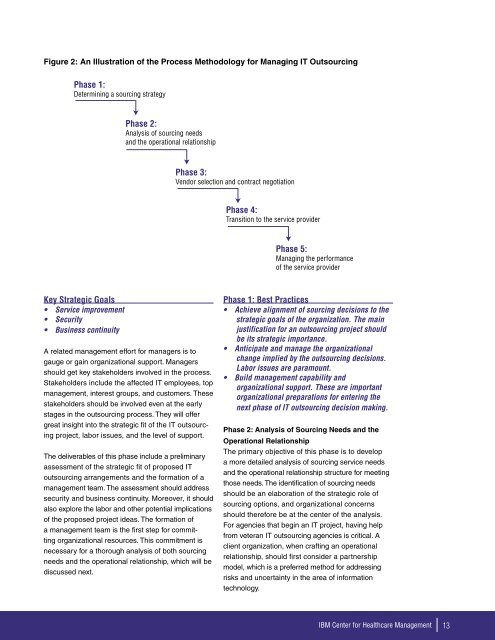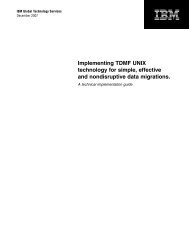A Primer for Healthcare Managers - IBM
A Primer for Healthcare Managers - IBM
A Primer for Healthcare Managers - IBM
Create successful ePaper yourself
Turn your PDF publications into a flip-book with our unique Google optimized e-Paper software.
Figure 2: An Illustration of the Process Methodology <strong>for</strong> Managing IT Outsourcing<br />
��������<br />
�������������������������������<br />
Key Strategic Goals<br />
• Service improvement<br />
• Security<br />
• Business continuity<br />
��������<br />
��������������������������<br />
��������������������������������<br />
A related management ef<strong>for</strong>t <strong>for</strong> managers is to<br />
gauge or gain organizational support. <strong>Managers</strong><br />
should get key stakeholders involved in the process.<br />
Stakeholders include the affected IT employees, top<br />
management, interest groups, and customers. These<br />
stakeholders should be involved even at the early<br />
stages in the outsourcing process. They will offer<br />
great insight into the strategic fit of the IT outsourcing<br />
project, labor issues, and the level of support.<br />
The deliverables of this phase include a preliminary<br />
assessment of the strategic fit of proposed IT<br />
outsourcing arrangements and the <strong>for</strong>mation of a<br />
management team. The assessment should address<br />
security and business continuity. Moreover, it should<br />
also explore the labor and other potential implications<br />
of the proposed project ideas. The <strong>for</strong>mation of<br />
a management team is the first step <strong>for</strong> committing<br />
organizational resources. This commitment is<br />
necessary <strong>for</strong> a thorough analysis of both sourcing<br />
needs and the operational relationship, which will be<br />
discussed next.<br />
��������<br />
�����������������������������������������<br />
��������<br />
����������������������������������<br />
��������<br />
������������������������<br />
�����������������������<br />
Phase 1: Best Practices<br />
• Achieve alignment of sourcing decisions to the<br />
strategic goals of the organization. The main<br />
justification <strong>for</strong> an outsourcing project should<br />
be its strategic importance.<br />
• Anticipate and manage the organizational<br />
change implied by the outsourcing decisions.<br />
Labor issues are paramount.<br />
• Build management capability and<br />
organizational support. These are important<br />
organizational preparations <strong>for</strong> entering the<br />
next phase of IT outsourcing decision making.<br />
Phase 2: Analysis of Sourcing Needs and the<br />
Operational Relationship<br />
The primary objective of this phase is to develop<br />
a more detailed analysis of sourcing service needs<br />
and the operational relationship structure <strong>for</strong> meeting<br />
those needs. The identification of sourcing needs<br />
should be an elaboration of the strategic role of<br />
sourcing options, and organizational concerns<br />
should there<strong>for</strong>e be at the center of the analysis.<br />
For agencies that begin an IT project, having help<br />
from veteran IT outsourcing agencies is critical. A<br />
client organization, when crafting an operational<br />
relationship, should first consider a partnership<br />
model, which is a preferred method <strong>for</strong> addressing<br />
risks and uncertainty in the area of in<strong>for</strong>mation<br />
technology.<br />
<strong>IBM</strong> Center <strong>for</strong> <strong>Healthcare</strong> Management 13

















